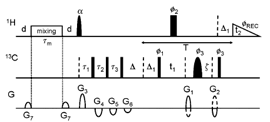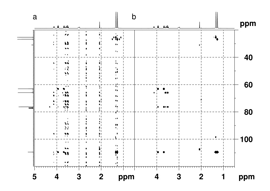NMR Methodology
(J. Furrer)
a) HMBC Experiments |
b) 1D ROESY |
c) DEPT |
a) HMBC Experiments
The 2D HMBC NMR experiment is probably the most useful and the most widely used 2D heteronuclear NMR method in the field of structural elucidation of complex organic molecular structures. Nowadays, the HMBC experiment has become the most popular techniques for multiple-bond (or long-range) heteronuclear chemical shift correlation. The HMBC experiment can span quaternary carbons or heteronuclei, providing a way to link different molecular fragments into a complete structure. Therefore, HMBC experiments have rapidly become the standard way of detecting the presence of long-range couplings in small to medium size molecules and for building and checking molecular skeletons, and are ideally suited when a carbonyl moiety or other non-protonated carbon group is involved. An ideal HMBC experiment would allow the detection of the maximal number of long-range couplings with the highest sensitivity and powerful low-pass filtering properties to reject unwanted 1JCH signals in the spectra. In the last years, some new HMBC pulse sequences have been proposed for enhancing the 1JCH suppression.
Pulse sequence of the IMPACT-HMBC experiment
... full size
Two-dimensional HMBC spectra of isopropylidene glycerol recorded at 400 MHz with (a) the standard HMBC experiment, and (b) with the IMPACT-HMBC experiment ... full size
Further Reading
- |
J. Furrer |
- |
J. Furrer, D. Thévenet |
- |
J. Furrer |
- |
J. Furrer |
- |
D. Jeannerat, J. Furrer |
| - | J. Furrer Conc. Magn. Reson. A 40A, 101-127, 2012. |
| - | J. Furrer Conc. Magn. Reson. A 40A, 146-169, 2012. |



